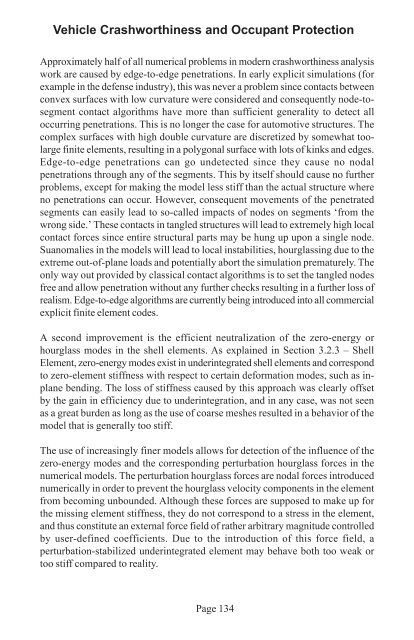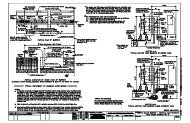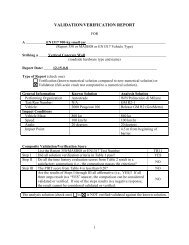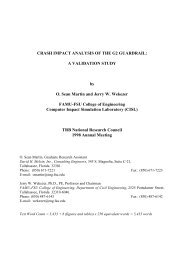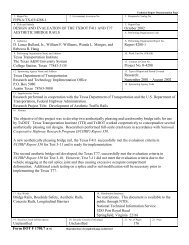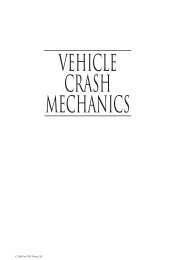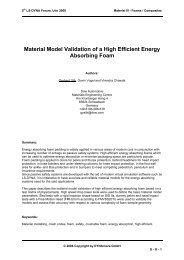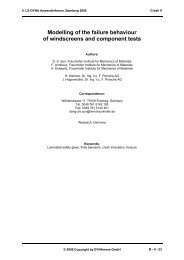Vehicle Crashworthiness and Occupant Protection - Chapter 3
Vehicle Crashworthiness and Occupant Protection - Chapter 3
Vehicle Crashworthiness and Occupant Protection - Chapter 3
Create successful ePaper yourself
Turn your PDF publications into a flip-book with our unique Google optimized e-Paper software.
<strong>Vehicle</strong> <strong>Crashworthiness</strong> <strong>and</strong> <strong>Occupant</strong> <strong>Protection</strong><br />
Approximately half of all numerical problems in modern crashworthiness analysis<br />
work are caused by edge-to-edge penetrations. In early explicit simulations (for<br />
example in the defense industry), this was never a problem since contacts between<br />
convex surfaces with low curvature were considered <strong>and</strong> consequently node-tosegment<br />
contact algorithms have more than sufficient generality to detect all<br />
occurring penetrations. This is no longer the case for automotive structures. The<br />
complex surfaces with high double curvature are discretized by somewhat toolarge<br />
finite elements, resulting in a polygonal surface with lots of kinks <strong>and</strong> edges.<br />
Edge-to-edge penetrations can go undetected since they cause no nodal<br />
penetrations through any of the segments. This by itself should cause no further<br />
problems, except for making the model less stiff than the actual structure where<br />
no penetrations can occur. However, consequent movements of the penetrated<br />
segments can easily lead to so-called impacts of nodes on segments ‘from the<br />
wrong side.’ These contacts in tangled structures will lead to extremely high local<br />
contact forces since entire structural parts may be hung up upon a single node.<br />
Suanomalies in the models will lead to local instabilities, hourglassing due to the<br />
extreme out-of-plane loads <strong>and</strong> potentially abort the simulation prematurely. The<br />
only way out provided by classical contact algorithms is to set the tangled nodes<br />
free <strong>and</strong> allow penetration without any further checks resulting in a further loss of<br />
realism. Edge-to-edge algorithms are currently being introduced into all commercial<br />
explicit finite element codes.<br />
A second improvement is the efficient neutralization of the zero-energy or<br />
hourglass modes in the shell elements. As explained in Section 3.2.3 – Shell<br />
Element, zero-energy modes exist in underintegrated shell elements <strong>and</strong> correspond<br />
to zero-element stiffness with respect to certain deformation modes, such as inplane<br />
bending. The loss of stiffness caused by this approach was clearly offset<br />
by the gain in efficiency due to underintegration, <strong>and</strong> in any case, was not seen<br />
as a great burden as long as the use of coarse meshes resulted in a behavior of the<br />
model that is generally too stiff.<br />
The use of increasingly finer models allows for detection of the influence of the<br />
zero-energy modes <strong>and</strong> the corresponding perturbation hourglass forces in the<br />
numerical models. The perturbation hourglass forces are nodal forces introduced<br />
numerically in order to prevent the hourglass velocity components in the element<br />
from becoming unbounded. Although these forces are supposed to make up for<br />
the missing element stiffness, they do not correspond to a stress in the element,<br />
<strong>and</strong> thus constitute an external force field of rather arbitrary magnitude controlled<br />
by user-defined coefficients. Due to the introduction of this force field, a<br />
perturbation-stabilized underintegrated element may behave both too weak or<br />
too stiff compared to reality.<br />
Page 134


